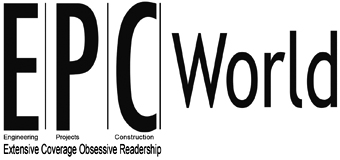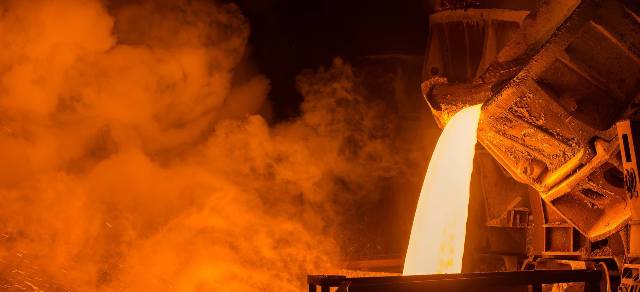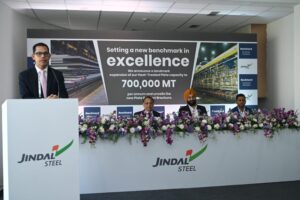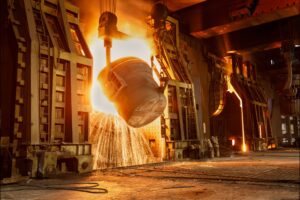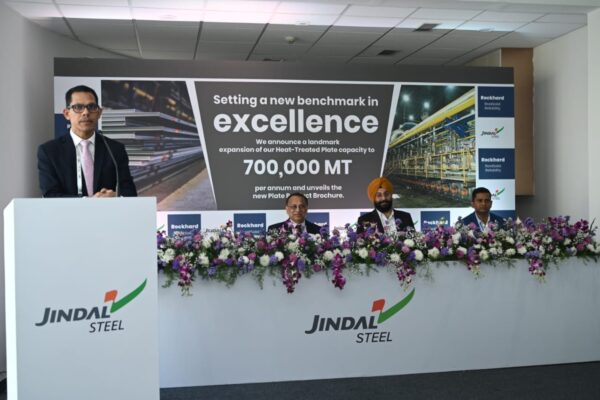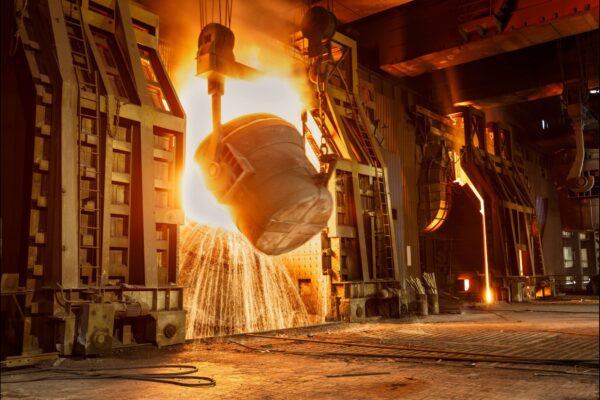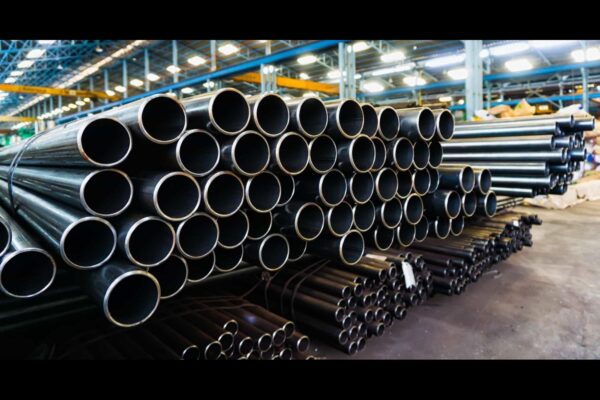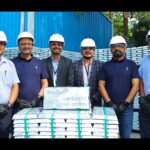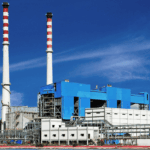Steel: Dependent industries look for a better deal
Increasing steel prices have hit the dependent industries the most. Many of the dependent industries are in the devil and deep sea situation, neither can they pass on the increasing prices to the end customers nor can they bear dent in their profitability. The industry is keen on fixed price contract with the steel manufactures
Of late, the steel industry is having a gala time. The domestic steel manufacturers have registered good profitability in the past few quarters. India is now the second largest steel producer of crude steel after China.According to Press Information Bureau (PIB), the nodal agency of the Government of India, total steel production capacity of the country at present is 143.91 million tonnes. According to the World Steel Association, India's crude steel production rose by 21.4 per cent year-on-year to 9.4 million tonnes (MT) in June. The crude steel output was 6.9 MT steel in the same month a year ago.The average domestic steel prices have surged 26% y-o-y in FY21 and 23.5% in Q1FY21. The prices reached record levels of Rs 56,000/MT in May 2021 and dipped to Rs 52,000/MT in June 2021, according to India Ratings.Increase in steel prices, better realization, leveraging technology has helped the steel companies to report profitability in the past few quarters. In Q1FY22, Jindal Steel and Power registered a staggering ten-fold rise in its consolidated profit. The company posted consolidated net profit of Rs.2,515.71 crore during the quarter under review, as opposed to Rs.235.71 crore in the year-ago period. JSW Steel recorded its highest-ever consolidated net profit at Rs.5,904 core in Q1FY22, on low base effect. The company has posted a consolidated loss of Rs.561 crore in the corresponding quarter last fiscal. The company also recorded its highest ever consolidated revenue at Rs.28,902 crore in Q1 FY22, a 145 per cent rise as compared to Rs.11,782 crore in Q1 FY21.The government owned Steel Authority of India (SAIL) reported a consolidated net profit of Rs 3,897 crore for the first quarter of 2021-22, as against a loss of Rs 1,226 crore a year ago. The company had reported a net profit of Rs 3,470 crore for the previous quarter. “Though the demand for steel products in the quarter has not had the same momentum as during Q4 of FY’21, focused interventions in several areas of operations have helped in achieving this robust performance,” said Soma Mondal, chairman, SAIL.Tata Steel BSL posted a consolidated net profit of Rs 2,478 crore in Q1FY21. The company had clocked Rs 650-crore net loss in the April-June quarter of the financial year 2020-21. “While Q1FY21 was significantly impacted by the government induced lockdown, the sector witnessed a significant turnaround post Q1FY21. The turnaround was not reflective only in terms of improvement in the sales volume for the industry, but the rising steel prices more than proportionate rise in raw material prices resulted into significant improvement in profitability for the domestic steel manufacturers. Hence, despite of a lower sales volume for the industry, the steel players profitability witnessed a significant improvement,” says Hitesh Avachat, Associate Director – Corporate Ratings, CARE Ratings.
Rising steel prices a serious concern
According to India Ratings, the average domestic steel prices surged 26% y-o-y in FY21 and 23.5% in Q1FY21. The prices reached record levels of Rs 56,000/MT in May 2021 and dipped to Rs 52,000/MT in June 2021. “In January 2021, when both iron ore and steel prices were at its peak, NMDC, India’s largest iron ore producer and a GoI owned entity had increased iron ore prices [NMDC (0-10mm, Fe64%)] to INR4,810/MT in January 2021, 65% or INR1,900/MT higher on a yoy basis. Simultaneously, flat steel prices [Indian, HRC (Mumbai 2.5mm-8mm, IS2062)] were at INR55,500/MT, 41% or INR16,250/MT higher on a yoy basis. Accordingly, there was a significant cost push. However, the robust steel demand and short supply of steel caused a disproportionate increase in steel prices,” says Rohit Sadaka, Director, India Ratings and Research.
Hot Rolled Coil (HRC) and Cold Rolled Coil (CRC)are flat steel used in consumer-friendly industries such as auto, appliances and construction. In a report in a leading daily, the domestic steel makers have hiked the prices of HRC and CRC by Rs. 4,000 and Rs. 4,500 per tonne, respectively.A tonne of HRC will now cost Rs.67,000 and CRC Rs. 80,000.Union road transport minister Nitin Gadkari has raised concern on the ever increasing steel prices which is affecting the infrastructure development of the country. The realty playerstoo opined that big players in the steel industry are indulging in cartelisation to jack-up prices. The minister express the exorbitant increase in steel prices in not necessitated as all players in the steel industry have their own iron mines, have not hiked labour wages nor isthere increase in power rate. “In January 2021, when both iron ore and steel prices were at its peak, NMDC, India’s largest iron ore producer and a GoI owned entity had increased iron ore prices [NMDC (0-10mm, Fe64%)] to INR4,810/MT in January 2021, 65% or INR1,900/MT higher on a yoy basis. Simultaneously, flat steel prices [Indian, HRC (Mumbai 2.5mm-8mm, IS2062)] were at INR55,500/MT, 41% or INR16,250/MT higher on a yoy basis. Accordingly, there was a significant cost push. However, the robust steel demand and short supply of steel caused a disproportionate increase in steel prices,” says Rohit Sadaka, Director, India Ratings and Research. The Competition Commission of India (CCI) has taken note of it
According to India Ratings and Research, engineering procurement & construction (EPC) companies have been facing doldrums majorly on account of a rise in steel and cement prices, while the impact of the second covid wave on the execution profile is marginal.The report further states, the EPC sector has been facing the brunt of increase in domestic steel prices since FY21. Typically, the order book visibility of the EPC sector ranges between 2.5x-3x of revenues. EPC players usually try to build in increases in raw material prices in their bids by estimating fluctuations based on past trends which makes them susceptible to any sharp price surges. The recent surge in steel prices is a cause for greater concern for players who have a substantial quantum of unexecuted order book, awarded prior to FY21.
Considering the high increase in steel prices many an EPC are keen to renegotiate with the domestic steel players for fixed priced annual contract. We spoke to few of the players who are very much concern and have voiced their opinion against this exorbitant increase in steel prices.The hardest hit by the increasing steel prices is the real estate player. Even before the Pandemic reared its head, realty sector was in a subdued phase. The Pandemic further dented the realty sector. Just when things were starting to look better for the realty sector, high building materials cost dashed any hope on a revival. EPC World spoke to few of the realty players to assess the damages done on account of increasing building materials prices. Dr. Niranjan Hiranandani, CMD, Hiranandani Communities and National President, Naredco, said, “The skyrocketing prices of essential raw materials like steel, cement, aluminium, copper wire has led to increase in input cost, consequently leading to rise in cost of construction. The exponential spike in raw material cost is due to supply chain disruption during Covid times and practice of cartelization. This escalation in input cost will impact the viability of the projects, cause delay in construction and delivery and also lead to increase in pricing. Till now, the developers managed to absorb the cost as consumer sentiment was muted, eventually with pressure building up the prices of homes is bound to rise. Industry is hopeful of government intervention to ease the hurdles in construction work and stabilize the inflationary pressure.”
Pre-Engineered Buildings (PEB) industry has taken a hit. This industry which was ducked the trend in the initial stages of the Pandemic with extensive orders for new warehouses on account on increasing e-commerce has now at the tag end of the Pandemic is badly battered due to increasing steel prices. Needless to say, steel accounts for almost 90 percent of the PEB structure. With exhorbitant increase in steel prices, it is a catch-22 situation for the PEB players. Arvind Nanda, Founder Director & CEO, Interarch Building Products has put it very thoughtfully the situation the PEB players are facing. “The exponential steel price increase, which is at a historic high currently, has totally disrupted the pre-engineered building industry. PEB has never had the luxury of variable price contracts and consequently, the industry is suffering very badly. Steel companies do not agree to a fixed-price contract with buyers at such times. No steel company agrees to it. For PEB company, the orders which are taken at fixed prices from clients, and have to be executed a few months later at very much higher steel prices, make the company lose money and cause chaos. The working capital requirements have also gone up autonomously. Banks are not ready to increase limits at short notice and PEB companies have to pay steel mills in advance, therefore making the situation worse. “Due to higher prices, order intake has also reduced as clients would prefer to delay their projects, as they do not want to make warehouses or factory buildings with steel at these historic highs. Everyone feels the prices will come down and would prefer to wait.So it has lead to a triple whammy……….making losses due to fixed-price contracts, working capital requirements going up and consequently higher costs and drastic reduction in orders as clients prefer to wait !!! and steel company not agreeing to any long term fixed prices.So all in all a bad time for all……"
D Raju, Managing Director & CEO, Kirby Building Systems & Structures India too expresses the challenges faced by the PEB players on account of increasing steel prices. “One of the biggest challenges that the PEB industry is facing for the last one year is with regards to steel prices that have shot up by more than 70 per cent. This has put a dent to the speedy implementation of projects specifically in the infrastructure & industrial sectors as steel accounts for about 90% of the building share. This unprecedented increase directly affects the capex of any particular project thereby changing the dynamics of overall financials during project implementation. Kirby India has also been impacted because of this price increase where we had to re-negotiate most of the projects with the customers based on the prevailing market price or future price depending on their project schedule.Steel mills are also asking for current prices as and when the order for material procurement is finalized. We, as an industry are looking forward to government support in such a way that more preference is given to the domestic steel consumers instead of exporting the steel and support the local industries by supplying steel at an economical price,” says D Raju.
After the initial stoppage in work due to the Pandemic, road and highways construction was back on track, so were the railways. Later on, other with partial opening of the lockdown other infrastructure followed suit. This move brought in increase sales for the construction equipment. But now with steel prices increase the construction equipment sector too have taken a hit. V G Sakthikumar, Managing Director, Schwing Stetter India, a leading industry voice for the betterment of the construction equipment industry explains, “The exponential increase leads unstable forecast on the price variations. Also, we find that while we try to negotiate with the major steel suppliers, they offer prices on monthly basis and are unwilling to enter into Fixed price annual price. This is due to their inclination/keenness to export and see better realization. We are exploring the other avenues to stay competitive in the CE business.”
The CE industry players lament the increase in steel prices and hope for the government to come up with relief for the sector. Dheeraj Panda, Director – Sales, Marketing and Customer Support, Sany Heavy Industry India, says “The sharp rises in raw material prices of steel have impacted the recovery of the construction equipment industry, battered by the pandemic. OEMs and as well as the vendors largely MSMEs are currently facing adverse impacts on the cost competitiveness due to the escalation in project costs, as a result of increased steel prices.As the CE industry is struggling hardback to normalcy – the equipment manufacturers are finding it difficult to absorb this high-cost burden. It would be tough to sustain our export orders if the prices do not reduce. However, the government has assured to take appropriate measures to tame rising steel prices by reducing the logistics cost and import duty. We hope that they will provide relief to the CE manufacturers and MSMEs, which has been hit hard amidst the raging pandemic.
Concerned about the same, we also have tried to negotiate for a fixed-price annual contract from our suppliers. But as the current circumstances are also not in favour of steelmakers and they are incurring heavy losses due to inflation. It seems impossible right now to finalize such a deal.”
Riding on the e-commerce wave Material Handling Equipment (MHE) players have logged a decent profit amidst the Pandemic. But not with steel prices on a all-time high things are looking dicey for the MHE players. “Steel has a major share in material handling equipment and its sub-assemblies, which results in a great influence over the pricing of the equipment. The industry has been considerably affected by the exponential increase in steel prices. The material handling business at Godrej & Boyce has had multiple rounds of discussions with the domestic steel players to establish a fixed-price annual contract to hedge against this price volatility and we are hoping for a positive outcome,” says Anil Lingayat, Executive Vice President and Business Head, Godrej Material Handling..
Government initiatives: A helping hand
To boost domestic manufacturing and cut down on import bills, the Union Cabinet has approved the Production-Linked Incentive (PLI) scheme. This scheme aimed at encouraging domestic manufacturing, substituting imports and finally boosting exports. In other words, the PLI scheme over a period of five years aims to augment domestic manufacturing and enhance export capabilities in the speciality steel sector. The PLI scheme envisages achieving this by providing incentives to the identified steel subsectors. With the budgetary outlay of Rs. 63.22 billion, the PLI scheme will be implemented for a five-year period, from 2023-24 to 2027-28. In 2020-21, India imported 6.7 MT of steel, out of which 4 MT was specialty steel, worth Rs. 300 billion. Through the PLI scheme, India wants to plug this gap in market demand by sourcing domestically and creating products for export. The PLI scheme is expected to draw investments worth approximately Rs. 400 billion and expand capacity of specialty steel by 25 MT from 18 MT in 2020-21 to 42 MT in 2026-27. This scheme is expected to not only boost export but will also generate employment opportunities. The finance minister Nirmala Sitharaman has announced a reduction in customs duty on flat steel products to 7.5% from 12.5%, and on long products to 7.5% from 10% earlier, making imports cheaper. To safe guard the domestic steel manufacturers from cheap import the government has extended the anti-dumping duty on certain variety of steel products originating from countries, including China, Japan and Korea. According to the government notification by the duties on 'Hot-Rolled flat products of alloy or non-alloy steel' originating in or exported from China, Japan, Korea, Russia, and Brazil, and on 'Cold-Rolled flat products of alloy or non-alloy steel' coming from China, Japan, and Korea, have been extended.
High steel price a concern
From being a industry with little modernization to now a technology driven industry ready to take on stage at the world platform, the steel industry has come a long way. In the past few quarters the industry has logged in exceptional profitability well beyond expectations. But in the last couple of years high increase steel products prices has been a matter of concern for the dependent industry. In an infrastructure project, steel is used anywhere between 60 to 90 percent. This increase is hurting not only the private projects but also the government owned projects. The government has time and again safeguarded protected the steel industry by imposing ‘anti dumping duties’ against cheap imports. Now it is industry turn to start a new leaf.
